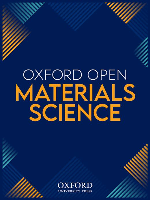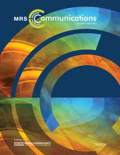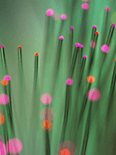
Interdisciplinary Materials
Scope & Guideline
Pioneering Discoveries in Materials Innovation
Introduction
Aims and Scopes
- Advanced Materials for Energy Storage and Conversion:
Research on innovative materials and methods for improving the efficiency and performance of energy storage devices, such as batteries and supercapacitors. - Biomaterials and Biomedical Applications:
Development of new biomaterials for medical applications, including drug delivery systems, tissue engineering, and diagnostics. - Nanomaterials and Nanotechnology:
Exploration of nanostructured materials and their unique properties, leading to advancements in electronics, catalysis, and environmental applications. - Sustainable and Recyclable Materials:
Focus on materials that are environmentally friendly, recyclable, or derived from renewable sources, addressing the challenges of waste and sustainability. - Interfacial and Surface Engineering:
Research on the manipulation of surfaces and interfaces to enhance material properties and functionalities, particularly in electronic and energy applications. - Computational Materials Science:
Utilization of computational methods and machine learning to predict material behaviors and design new materials with desired properties.
Trending and Emerging
- Smart and Responsive Materials:
There is a growing interest in materials that can respond to environmental stimuli, such as temperature, pH, or light, which are critical for applications in sensors and actuators. - Electrochemical Energy Systems:
Research on electrochemical systems, particularly regarding lithium-ion and sodium-ion batteries, is trending, driven by the demand for efficient energy storage solutions. - Biomimetic and Bioinspired Materials:
An increasing trend towards materials inspired by biological systems is evident, with applications in medicine, engineering, and environmental sustainability. - 3D Printing and Additive Manufacturing:
The rise of 3D printing technologies is reflected in the journal's publications, focusing on novel materials and processes that enable complex geometries and functionalities. - Integration of AI and Machine Learning in Materials Science:
The incorporation of artificial intelligence and machine learning techniques for materials discovery and design is emerging as a crucial area, enhancing research efficiency and innovation.
Declining or Waning
- Traditional Bulk Materials:
Research on conventional bulk materials appears to be declining, as the field shifts towards more innovative, composite, and nanostructured materials that offer enhanced properties. - Basic Theoretical Studies:
There seems to be a waning interest in purely theoretical studies without practical applications, as researchers increasingly seek to connect theoretical insights with experimental validation and real-world applications. - Single-Use Materials:
The focus on materials designed for single-use applications is fading in favor of developing multifunctional and sustainable materials that can serve multiple purposes and reduce waste.
Similar Journals

Oxford Open Materials Science
Connecting Scholars to Transform Materials ScienceOxford Open Materials Science is a pioneering peer-reviewed journal published by Oxford University Press that serves as a leading platform for the open-access dissemination of original research in the field of materials science. With its inception in 2021, the journal has quickly established itself as a significant contributor to the scholarly community, achieving a commendable Q2 ranking in the Materials Science (miscellaneous) category as of 2023, and holding the 252nd position out of 463 in the Scopus ranking for general materials science. This journal not only fosters innovative research and collaboration among experts, practitioners, and students but also emphasizes the importance of unrestricted access to knowledge. With the open-access model, it ensures that high-quality research is universally accessible, paving the way for advancements in material applications and technologies. Oxford Open Materials Science is dedicated to promoting the exchange of ideas and findings essential for the scientific progress of materials science, making it an invaluable resource for today's researchers and industry professionals.

NPG Asia Materials
Pioneering Insights for a Material WorldNPG Asia Materials, a premier journal published by NATURE PORTFOLIO, stands at the forefront of research in the fields of condensed matter physics, materials science, and modeling and simulation. With an impressive Impact Factor gracing its Q1 rankings in 2023, this open-access journal, established in 2012, offers a vital platform for disseminating high-quality research articles, reviews, and perspectives that advance the understanding of material properties and innovative applications. Based in the United States and catering to a global audience, NPG Asia Materials features cutting-edge contributions that not only enhance academic scholarship but also provoke discussions relevant to both industry and academia. Researchers, professionals, and students are invited to explore its extensive archive of work, covering insights from 2009 to 2024, in a bid to stay abreast of the latest developments in these rapidly evolving scientific domains.

MRS Communications
Advancing materials science through collaborative insights.MRS Communications is a prominent academic journal published by Springer Heidelberg, focusing on the multidisciplinary field of materials science. With ISSN 2159-6859 and E-ISSN 2159-6867, this journal has been a valuable platform for disseminating cutting-edge research since its inception in 2011. Operating from its esteemed headquarters in Heidelberg, Germany, it aims to foster collaboration and innovation among researchers and practitioners by publishing high-quality, peer-reviewed articles. Holding a Q3 ranking in the Materials Science (Miscellaneous) category, and currently positioned at the 37th percentile in the general materials science field, MRS Communications is dedicated to advancing the understanding of materials through interdisciplinary studies. The journal offers researchers an opportunity to share insights that bridge theoretical knowledge with practical applications, contributing significantly to the global materials science community. As an essential resource for researchers, professionals, and students alike, we invite you to explore the latest advancements and discussions in materials science through this influential publication.

SmartMat
Fostering Collaboration Across Chemistry and Materials Science.SmartMat is a cutting-edge, peer-reviewed academic journal published by WILEY, dedicated to the fields of Chemistry, Materials Science, and Mechanics of Materials. Launched in 2020, this Open Access journal aims to disseminate high-quality research and innovative findings that bridge these interdisciplinary areas. With an impressive impact factor reflecting its strong scholarly influence, SmartMat currently holds the prestigious Q1 category ranking in key domains such as Chemistry (miscellaneous), Materials Science (miscellaneous), and Mechanics of Materials, underscoring its relevance and importance in advancing material research. The journal is ranked among the top in its fields on Scopus, with 98th and 97th percentiles for Engineering and Chemistry rankings, respectively. Researchers, professionals, and students looking for a platform to share advancements in smart materials and their applications are encouraged to explore the wide-ranging access options available, enhancing visibility and engagement with global scientific communities.

Annual Review of Materials Research
Navigating the Evolving Landscape of MaterialsThe Annual Review of Materials Research, published by ANNUAL REVIEWS, is a pivotal journal in the realm of Materials Science, recognized for its rigorous reviews that bridge the gap between foundational research and advanced applications. With a prestigious ranking of Q1 in the category of General Materials Science and a commendable position at #24 out of 463 in Scopus, it ranks in the 94th percentile among its peers, underscoring its significance and influence in the field. Over the years, from 2003 to 2023, the journal has become an essential resource for researchers, professionals, and students alike, offering comprehensive insights into the evolving landscape of materials science. Although it does not operate under an open access model, its content remains invaluable for advancing knowledge and fostering innovation. The journal’s scope encompasses a wide array of interdisciplinary topics, making it a go-to source for those seeking to stay at the forefront of materials research.

Materials Today Advances
Unlocking innovations in materials and mechanical engineering.Materials Today Advances is a premier open access journal, published by Elsevier, dedicated to disseminating cutting-edge research in the fields of Materials Science and Mechanical Engineering. Since its inception in 2019, the journal has quickly established itself within the academic community, achieving an impressive Q1 quartile ranking in both disciplines as of 2023, indicative of its high-impact contributions. Ranked #25 out of 672 in Mechanical Engineering and #46 out of 463 in General Materials Science according to Scopus, Materials Today Advances offers rigorous peer-reviewed articles that address the latest innovations and interdisciplinary approaches. Researchers, professionals, and students can benefit from the journal's open access model, ensuring widespread visibility and accessibility of groundbreaking findings. With the convergence of advanced materials research and practical applications, this journal represents a vital resource for those at the forefront of scientific discovery.

Surfaces and Interfaces
Shaping the Future of Material InteractionsSurfaces and Interfaces is a leading international journal published by Elsevier, dedicated to advancing the understanding of surface and interfacial phenomena across various disciplines, including chemistry, materials science, and physics. With an impressive impact factor placing it in the Q1 quartile for its categories as of 2023—spanning Chemistry, Condensed Matter Physics, and Surfaces, Coatings, and Films—this journal not only serves as a critical platform for innovative research but also reflects the dynamic nature of surface science in contemporary applications. The journal is indexed in Scopus, ranking 25th out of 132 in the Materials Science – Surfaces, Coatings and Films category, marking it in the top 19% of this prestigious field. Although it is not an open-access platform, the journal remains a vital source of curated academic material for researchers, professionals, and students seeking to deepen their knowledge and contribute to ongoing conversations in surface and interface science. Published from the heart of Europe in Amsterdam, Surfaces and Interfaces invites submissions that challenge conventional paradigms and explore the forefront of technology and materials.

BULLETIN OF MATERIALS SCIENCE
Advancing the Frontiers of Materials ScienceBulletin of Materials Science, published by the Indian Academy of Sciences, is a distinguished journal that has been contributing to the field of materials science since its inception in 1979. With an ISSN of 0250-4707 and E-ISSN 0973-7669, it provides a platform for researchers to share groundbreaking studies and advancements in the mechanics of materials and general materials science. As of 2023, the journal holds a respectable Q3 ranking in both the Materials Science (miscellaneous) and Mechanics of Materials categories, highlighting its competitive position in the academic landscape. Although the journal currently does not operate under an open access model, it remains a vital resource for professionals and students keen on exploring innovative material developments and methodologies. With a commitment to promoting high-quality research, the Bulletin of Materials Science features rigorous peer-review processes, making it an essential reference for anyone engaged in the materials science domain.

Materials Futures
Exploring innovative solutions for tomorrow's materials.Materials Futures, an esteemed journal published by IOP Publishing Ltd, stands out as a pivotal resource in the field of Materials Science, with a particular emphasis on Biomaterials. Launched in 2022 and operating under an Open Access model, the journal aims to foster accessibility and rapid dissemination of pioneering research, thus catering to the diverse needs of researchers, professionals, and students globally. With a commendable Scopus Rank of #46 out of 137 in its category, placing it in the 66th percentile, and recognized as a Q1 journal as of 2023, Materials Futures provides a vital platform for cutting-edge studies and innovations that address contemporary challenges in materials science. As the journal evolves through its convergence period from 2022 to 2024, it continues to attract high-quality submissions aimed at advancing knowledge and applications within the biomaterials sector, reflecting its commitment to contributing vital insights and fostering collaboration across disciplines. Explore Materials Futures for your research endeavors and join a community dedicated to shaping the future of materials.

Frontiers of Materials Science
Empowering Researchers with Open Access to Materials ScienceFrontiers of Materials Science is a groundbreaking journal dedicated to exploring advanced materials and their applications within the ever-evolving landscape of materials science. Published by HIGHER EDUCATION PRESS, this journal offers a crucial platform for scholars and practitioners seeking to disseminate innovative research findings that foster interdisciplinary collaboration. Since its inception in 2011, the journal has enjoyed a notable Q2 ranking in the category of Materials Science (miscellaneous) as of 2023, positioning it among the noteworthy publications in the field with a Scopus rank of #222 out of 463. While predominantly published in China, the journal is committed to open access principles, allowing global accessibility to cutting-edge research. With its comprehensive coverage spanning materials synthesis, characterization, properties, and applications, Frontiers of Materials Science not only serves as a repository for academia but also bridges the gap between research and industry, making it an indispensable resource for researchers, professionals, and students alike.